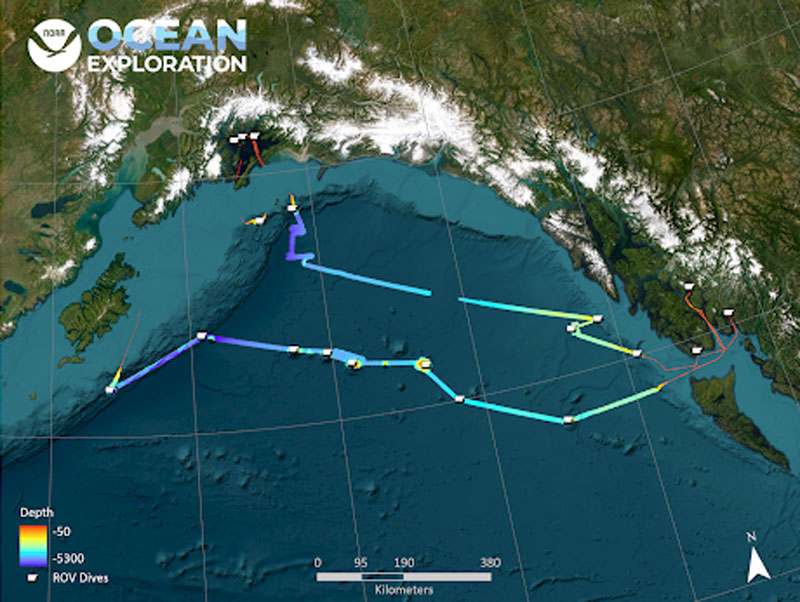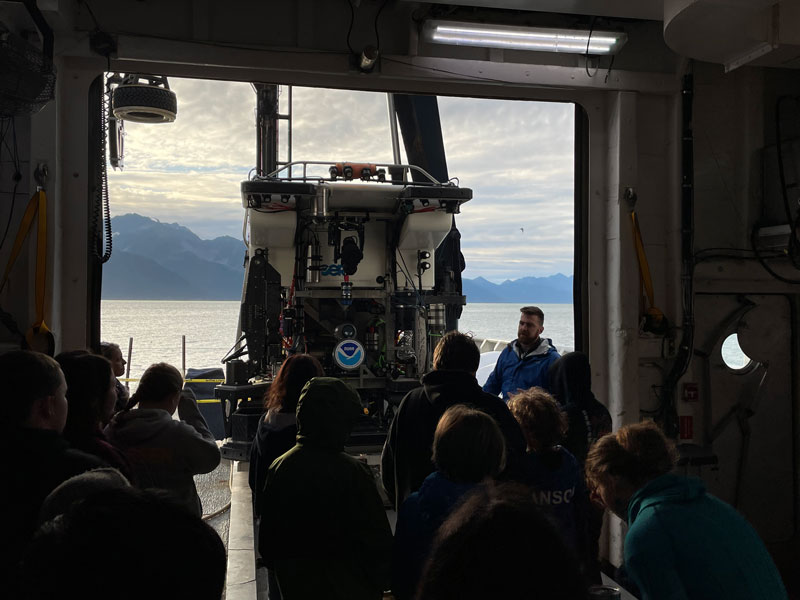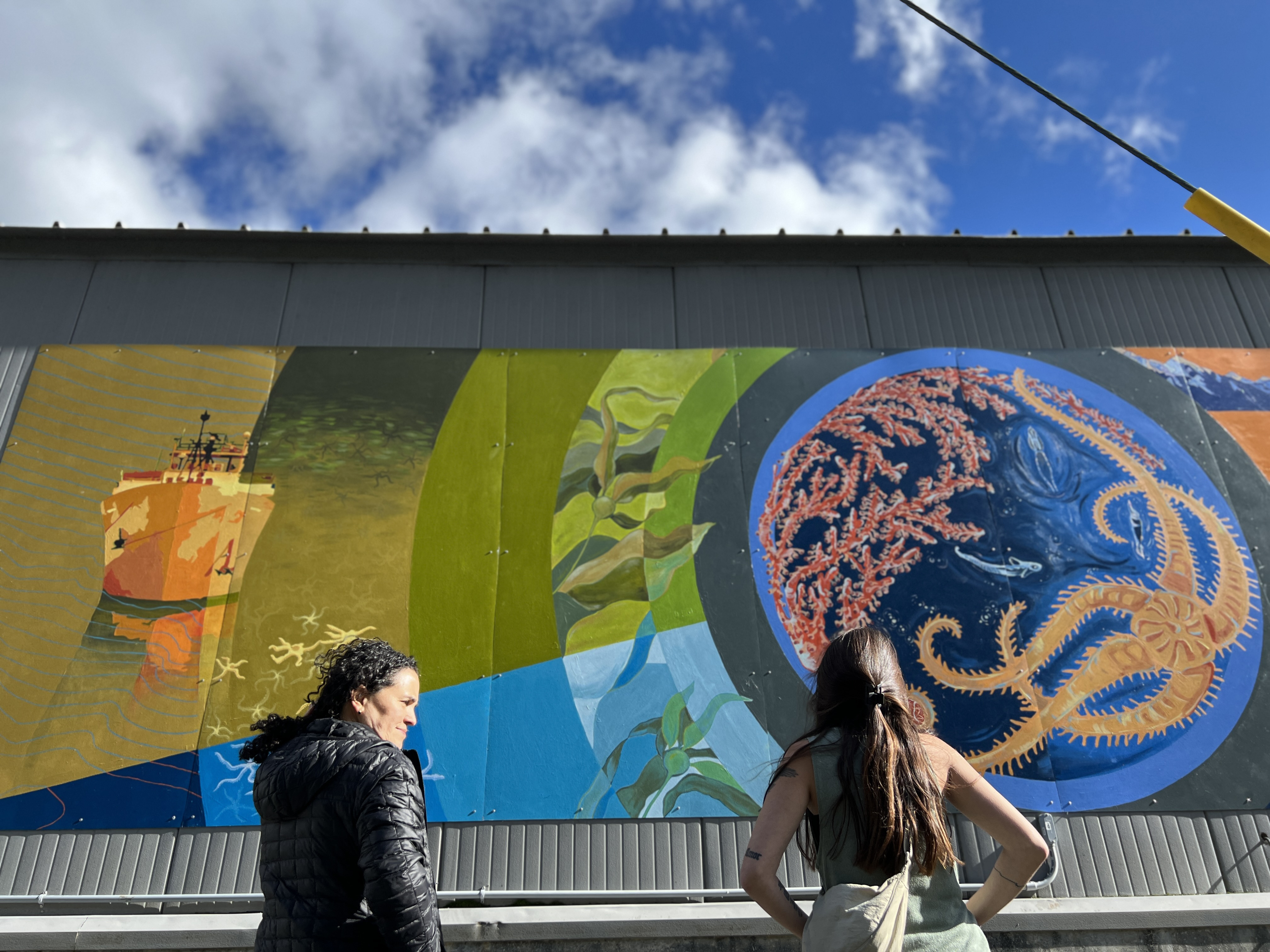Seascape Alaska 5: Gulf of Alaska Remotely Operated Vehicle Exploration and Mapping
(EX2306)
Expedition Summary
From August 23 - September 14, NOAA Ocean Exploration and partners conducted the fifth in a series of Seascape Alaska expeditions on NOAA Ship Okeanos Explorer. Operations during this 23-day expedition included 19 successful remotely operated vehicle (ROV) dives conducted in water depths ranging from 253 - 4,262 meters (830 - 13,983 feet), mapping of 28,287 square kilometers (10,922 square miles) of seafloor, and the collection of a wide variety of biological and geological samples. Altogether, data from the Seascape Alaska 5: Gulf of Alaska Remotely Operated Vehicle Exploration and Mapping expedition will contribute to our collective baseline understanding of the ocean, improving our ability to protect and manage marine ecosystems and furthering public awareness of the splendor, importance, and interconnectivity of the ocean to our everyday lives.
During the Seascape Alaska 5 expedition, the team navigated challenges ranging from rough weather to poor visibility, and completed 19 deepwater remotely operated vehicles (ROV) dives in the Gulf of Alaska and coastal fjords.
Operational Summary
- Days at sea: 23
- Full ROV dives: 19, ranging in depth from 253 - 4,262 meters (830 - 13,983 feet)
- Biological samples collected: 72 primary samples, 197 associates
- Geological samples collected: 32 primary samples, 13 associates
- Water samples collected for eDNA analysis: 70
- Seafloor area mapped: nearly 28,287 square kilometers (10,922 square miles)
- Science party participants: >50
- Live video views: Approximately 222,000

Expedition Priorities
Priority exploration areas identified by the ocean management and scientific communities included a diversity of features across the Gulf of Alaska. These ranged from areas with the potential to host deep-sea coral and sponge communities, to maritime heritage sites, a landslide feature, and even water column sonar anomalies possibly indicating the presence of cold seeps. Overnight mapping data collected during this expedition filled major data gaps in the region and will contribute to Seabed 2030 goals for mapping unexplored regions of the global seafloor.
Mapping Highlights
During the Seascape Alaska 5 expedition, the team mapped approximately 28,278 square kilometers (8,245 square miles) of seafloor. Often referred to as the first step in ocean exploration, seafloor mapping lays the groundwork for future exploration both through remotely operated vehicle dives during the expedition and through continued exploration by others. Mapping efforts extended bathymetric mapping coverage in both the U.S. Exclusive Economic Zone and in international waters in support of Seabed 2030, and filled critical gaps in our understanding of deepwater areas in the Gulf of Alaska.
Biological Highlights
Biological specimens collected during the Seascape Alaska 5 expedition included representatives of new records and species that are likely new to science. The team also recorded significant depth and geographic range extensions for several fish and coral species, and documented the presence of commercially important species. Deep-sea corals and sponges were observed on every dive aside from one, which was conducted specifically in search of an underwater cultural heritage target. These areas of deep-sea coral and sponge habitat not only improve our understanding of this region, but have habitat modeling implications that may apply to many other places in the world.


Geological Highlights
The exploration of submarine geology was another priority for this expedition. Geological samples collected will be used to better understand the geologic history of this region, as well as to characterize habitat substrate, while mapping and remotely operated vehicle imagery data support enhanced predictive capabilities for vulnerable marine habitats and submarine geohazards. During the expedition, the team identified new methane seeps and fully mapped a number of previously unmapped or poorly mapped seamounts in the Kodiak-Bowie and Patton Seamount Chains. The exploration of four seamounts in the Kodiak-Bowie seamount chain, along with numerous geological samples collected there for chemical and chronologic studies, will help scientists understand the origin of these hot spot volcanoes.


Public Engagement
During the expedition, the team engaged with audiences around the world, opening a window of understanding into the deep sea with over 222,000 livestream views, expedition web content that was viewed over 250,000 times, and media coverage that reached thousands. Community members visiting the Alaska Sea Life Center and students at the College of Charleston had the opportunity to engage with the expedition while the ship was at sea through live telepresence connections.
Once in port, the expedition team, partners, and other NOAA Ocean Exploration staff supported the first annual Seward Marine Science Symposium in Seward, Alaska. Ship tours were conducted for several local organizations and groups including middle and high school students and their teachers, homeschoolers, staff from Kenai Fjords National Park, members of the Qutekcak Native Tribe of Seward, leadership and staff from the Alaska Sea Life Center, the Alutiiq Pride Marine Institute, University of Alaska’s Seward Marine Center, local staff from the National Weather Service, local media, and more. These tours provided the opportunity for over 200 individuals to engage first hand with the exploration tools, samples, and expedition team, and to learn more about ocean exploration and its role in the greater ocean science field. Meanwhile, science talks from the expedition coordinator along with partners and other local scientists provided the opportunity for an exchange of ideas and new and continuing collaborations. A new public mural based on deep-sea imagery captured during the Seascape Alaska series of expeditions was also unveiled during the symposium, which brought in not only the expertise of local Seward-based artists, but of members of the local scientific community and the public at large.





Published January 22, 2024